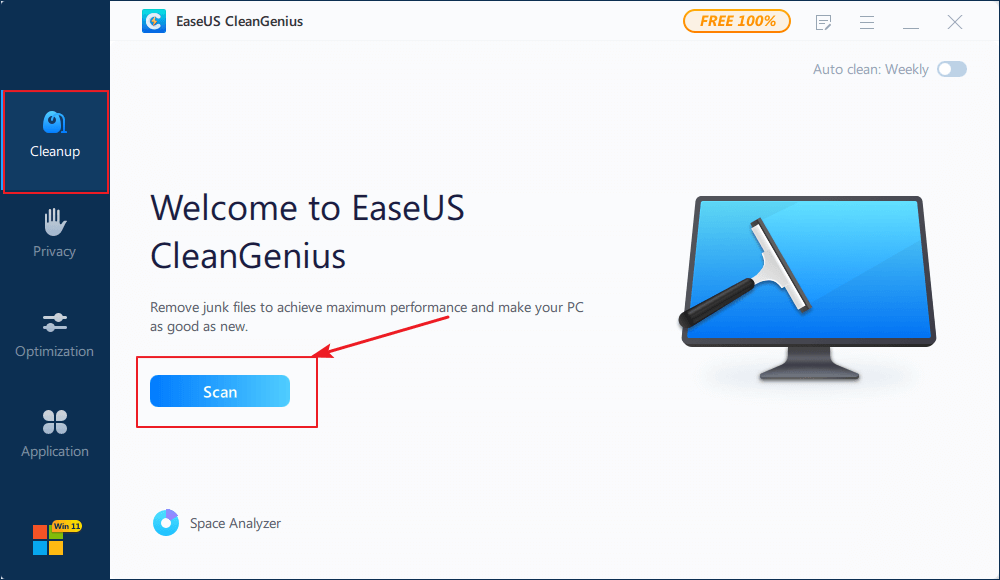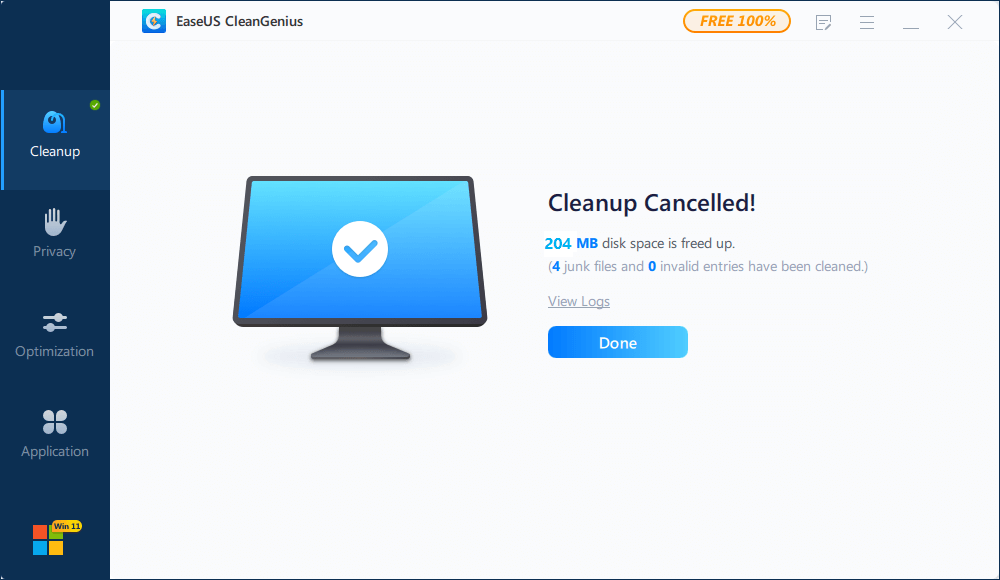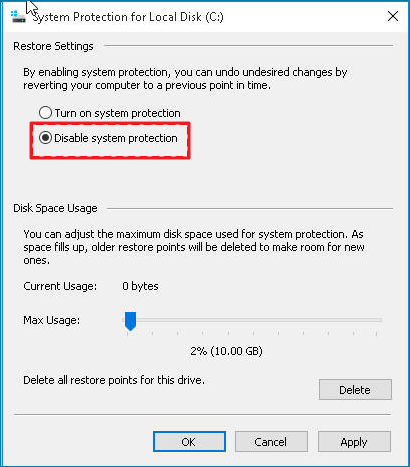Today I'm going to show you how to fix C drive filling up automatically for no reason step by step. Here is an overview of the solutions.
| Workable Solutions | Step-by-step Troubleshooting |
|---|---|
| 1. Run Disk Cleanup | Open "Start", search for Disk Cleanup and select the top result to open it....Full steps |
| 2. Disable Hibernation | Run Command Prompt as administrator. Input powercfg.exe /hibernate off...Full steps |
| 3. Delete System Restore Points | Right-click "This PC" and choose "Properties" among the listed results...Full steps |
| 4. Transfer Large Files/Apps | You can move large files and applications to another drive without effort...Full steps |
| 5. Extend C Drive Space | Launch EaseUS Partition Master. Shrink partition and leave unallocated space for extending C: drive...Full steps |
| 6. Migrate OS to a Bigger SSD/HDD | If the disk itself has less space, you can migrate Windows 10 to a bigger SSD...Full steps |
Real Case - C Drive Keeps Filling Up
"I have a 235 GB hard drive with very few programs loaded onto it and almost no picture or video files taking up space. The computer is hooked up to a network where I work, but nobody else has this problem. Even if I can free up several GB's of space, the C: drive will fill up in just a couple of days. Is there any advice about how to fix C drive keeps filling up automatically without reason?"
Many computer users complain about C drive full problems on the Internet. They don't store any files on the drive, and even they delete some files, their C drive keeps filling up. Why is C drive getting full automatically?
Reasons - Why C Drive Is Getting Full Automatically
Many factors can cause insufficient C drive space. Here I will list some of the most common reasons.
- Virus attacks
- File system corruption
- Enabled Windows restore points
- Too many temporary and cached files
- Little free space on C drive...
🔍Refer to: What Is Taking Up Space on My C Drive
Before You Start - Back Up Your System and Files
Now that you have learned about the reasons, you can fix the "C drive getting full automatically" issue accordingly. These tried-and-true solutions can solve your problem effectively. But before you start, you are suggested to create a system backup. Because there are some file deletion and cleaning operations on the system partition, you'd better make a system backup.
A system backup is a process of backing up the operating system, files, and system-related data. With the image, you can restore your operating system at any time. EaseUS backup and recovery software provides a one-key function of system backup for Windows 7/8/8.1/10 and the earlier Windows PC operating systems like Windows Vista and XP.
Secure Download
Fix 1. Run Disk Cleanup to Fix C Drive Filling Up Problem
After you have made a system backup, you can follow the operations below without worrying about your data. When the C drive keeps filling, you should run antivirus software and then clean up temporary files and other junk files.
- Open "Start", search for Disk Cleanup and select the top result to open it.
- Select the files that you want to delete from the C drive or other drives.
- Click the "OK" button.

If you don't have too much technical know-how, you can run a free tool - EaseUS CleanGenius to clean up system files with easy steps.
Step 1. Download and install EaseUS Partition Master Suite on your PC. Click to download PC Cleaner on panel.

Step 2. Install EaseUS CleanGenius on your PC. To begin with, navigate to "Cleanup" and click "Scan."

Step 3. EaseUS CleanGenius will start immediately to scan all the useless files, select system junk files and invalid entries, and click "Clean" over all your PC.

Step 4. Once completed, you can see clearly how many MBs or GBs of data are cleaned. Click "Done" to finish the process.

Fix 2. Disable Hibernation If C Drive Keeps Filling Up
Generated hibernation files often take up much space on your hard drive. The Hiberfil.sys is a hidden system file located in the drive's root folder where Windows is installed. To turn off hibernation mode, follow the steps below.
- Run Command Prompt as administrator.
- Input powercfg.exe /hibernate off and hit "Enter"
- Type exit, and then press "Enter" to close the Command Prompt window.

Fix 3. Delete System Restore Points in Windows 10
Windows Restore Points are effectively mini 'backups' of the operating system and are usually created when installing a driver or using Windows Update. It is helpful for disaster recovery but can also eat a tremendous amount of disk space and cause the C drive full problem over time. As I have mentioned before, system restore points are one of the reasons that cause C drive to get full automatically. Thus, you can disable the Windows System Protection to solve the problem.
- Right-click "This PC" and choose "Properties" among the listed results.
- On the left pane, choose "System Protection".
- In the small pop-up window, select "C drive" and click "Configure".
- In this window, select "Turn off system protection" and click "OK". You can click "Delete > Continue" to delete all system restore points and free up disk space.

Fix 4. Transfer Large Files/Apps to Another Drive
If you have installed large games like Steam or Blizzard on your C drive, you might be bothered by C drive full problems. You can move large files and applications to another drive without effort. EaseUS Todo PCTrans moves applications, files, and accounts between computers in 1 click.
How to Move Large Files From One Drive to Another?
You can transfer files, programs, and games to another drive with simple clicks.

Fix 5. Extend/Increase C Drive Space
If your C drive is allocated with small space at first, you can use third-party partition manager software – EaseUS Partition Master to extend the C drive without data loss.
Extend System C drive with unallocated space
- 1. Right-click on the System C: drive and select "Resize/Move".
- 2. Drag the system partition end into the unallocated space so to add it to the C: drive. And click "OK".
- 3. Click "Execute Task" and "Apply" to execute the operations and extend the C drive.
Fix 6. Move/Migrate OS to a Bigger SSD/HDD
If the disk itself has less space, you can migrate Windows 10 to a bigger SSD or HDD. You can follow the guide to migrate Windows 10 to SSD or watch the video below.
Conclusion
That is all there is to it. The best solution is Fix 5 because you can allocate more space to your drive without losing data. If you found one of the solutions useful, I'd appreciate it if you would share it on Facebook. I'd also like to hear from you: have you fixed the C drive automatic full problem? Please send an email and let me know.
Secure Download
Was This Page Helpful?
Updated by Tracy King
Tracy became a member of the EaseUS content team in 2013. Being a technical writer for over 10 years, she is enthusiastic about sharing tips to assist readers in resolving complex issues in disk management, file transfer, PC & Mac performance optimization, etc., like an expert.
Jean is recognized as one of the most professional writers in EaseUS. She has kept improving her writing skills over the past 10 years and helped millions of her readers solve their tech problems on PC, Mac, and iOS devices.
Related Articles
-
How to Fix macOS 13 Ventura Installation Failed/Stuck/Frozen (2025 Tips)
![author icon]() Brithny/2025-07-07
Brithny/2025-07-07 -
How to Repair Damaged SD Card in Android
![author icon]() Tracy King/2025-07-04
Tracy King/2025-07-04 -
External Hard Drive Takes Forever to Load
![author icon]() Jean/2025-07-04
Jean/2025-07-04 -
Dash Cam Card Full Error: How to Fix 'Dash Cam Says SD Card Full'
![author icon]() Brithny/2025-07-04
Brithny/2025-07-04
EaseUS Data Recovery Services
EaseUS data recovery experts have uneaqualed expertise to repair disks/systems and salvage data from all devices like RAID, HDD, SSD, USB, etc.